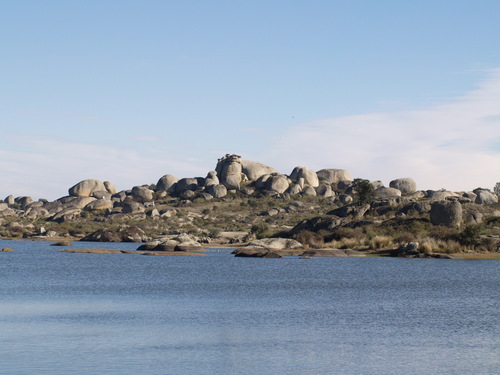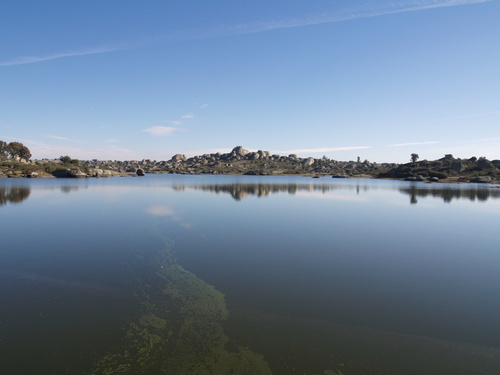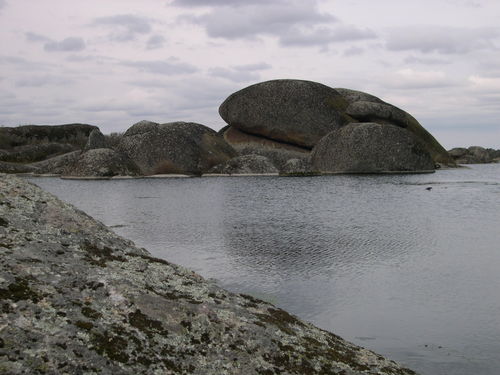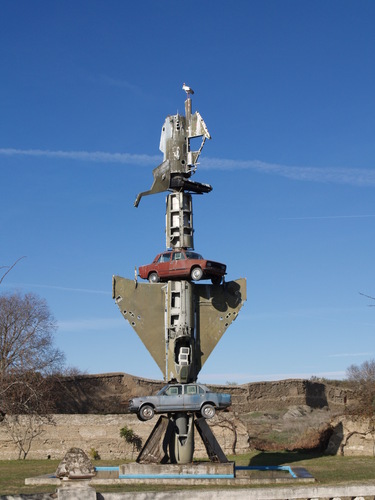575 million years ago, in the late Pre Cambrian period is not for many people a significant date, not like the Battle of Hastings or Waterloo, but for Spain it became very significant indeed. It was when Spain was born.
 At the time the land that was to become Spain was on the southern edge of a vast ocean well south of the equator and attached to the northern edge of a continental plate that would, much later, become Africa. It was a new addition to that plate, the volcanic processes that spewed molten rock from the Earth's core into the atmosphere were adding to the area of land above the sea on a daily basis.
At the time the land that was to become Spain was on the southern edge of a vast ocean well south of the equator and attached to the northern edge of a continental plate that would, much later, become Africa. It was a new addition to that plate, the volcanic processes that spewed molten rock from the Earth's core into the atmosphere were adding to the area of land above the sea on a daily basis.
The magma cooled and became granite on an Earth very different to that of today. There was no life as we know it, the primitive sea creatures that existed then were long extinct when the trilobites arrived, the atmosphere contained little or no oxygen, the land was coloured various shades of red and the sea was green.
Over millennia the peripatetic continental plates roamed the Earth, colliding, combining and merging. Some parts of the plates found themselves submerged beneath shallow seas and the granite was covered with sediment from eroded rocks and the skeletons of early living creatures, some parts were eaten away by glacial action, yet more granite suffered the same fate more slowly as a result of wind, rain, sleet and snow washing sediment into rivers where it became just another muddy layer at the bottom of a sea but one area of Spain managed to retain just a vestige of the original rock.
 It is 575 million years old, formed at the time Spain's bedrock solidified from the magma and it is only a short way from the Costa del Sol, a few kilometres west of Cásares in Extremadura in an area called Los Barruecos near the town of Malpartida de Cácares.
It is 575 million years old, formed at the time Spain's bedrock solidified from the magma and it is only a short way from the Costa del Sol, a few kilometres west of Cásares in Extremadura in an area called Los Barruecos near the town of Malpartida de Cácares.
From the moment the magma solidified into granite it started to erode. By a fluke of nature this area remained above water, so above ground, throughout the tumultuous years to follow. The erosion of the granite has been caused solely by the prevailing weather. In some areas of the world 575 million years would have been enough to erode all traces of even the bedrock granite but again this area was different.
It managed to avoid, through all its wanderings around the planet, great extremes of weather and it is very hard granite. The landscape now consists of low, rounded, masses of rock, surrounded by thin soil, the remains of the material eroded from the surrounding rock and not yet washed into the nearest stream, with occasional outcroppings of granite boulders, some elegantly balanced on others, some weathered into elaborate shapes, some forming high buttes, very similar to the karstic formations of Torcal but whereas Torcal's soft limestone is only 100 million years old and has eroded quickly into sharp edged features, Los Barruecos looks much more mature, more rounded, more permanent. It feels like the ancient landscape it is, which is possibly why prehistoric man made the area his home and some of the rocks his shrines.
It is not just prehistoric remains that bring people to Los Barruecos. Fishermen catch fat tench in the lakes, called charcas. The tench, fried, feature as a local delicacy. Historians gaze at the ruins of Roman villas that were built in the area. Twitchers are thrilled by the variety of birds that reside and migrate to here. Geologists study the granite and find flat hexagonal crystals of muscovite in the quartz veins towards the edge of the outcroppings and other minerals that were mined commercially.
 The abandoned adits are still to be seen with a couple of mills, including a wool washing mill, dating to the late 19th Century to excite the industrial archaeologist. Nor is the naturalist disappointed. It is hardly surprising that in a unique environment you will find a unique collection of plants.
The abandoned adits are still to be seen with a couple of mills, including a wool washing mill, dating to the late 19th Century to excite the industrial archaeologist. Nor is the naturalist disappointed. It is hardly surprising that in a unique environment you will find a unique collection of plants.
In such an alien environment the Centro de Interpretación has to be the place to start and, at Los Barruecos, the centre is excellent with full explanations of the landscape, how it was formed, how it has been used, and the plants, animals and birds you will find in it. Even before reaching the centre you will be tempted to stop alongside a natural pond to study the diverse wildfowl that live there.
Little grebes dive for the weed on the bottom, mallards float by with an attending court of pochards and coots, martins and swallows swoop low eating the insects attracted to the water whilst herons and egrets stand majestically in the shallows waiting for their next meal to swim along ignoring the purple gallinules squabbling in the reeds. If you are lucky you will see a resident Montagu's Harrier perched on a pylon or swooping majestically low overhead. In mid September she was keeping a watchful eye on her two young offspring who were learning to hunt.
With such an introduction to the area and armed with a map from the centre you can then don boots and embark on one of the walks within the park. There are three marked routes, the longest about twelve kilometres although you will find it much longer since you will be diverted away from the main route to look at places of interest. The centre actually recommends that you wander off the beaten track to see some of the more remote features.
Starting from the parking area shown as most southerly on the map you do not have to go far to see the first prehistoric remains. Alongside the car park is a large group of boulders. In the granite beneath them, an unknown length of time ago, man made his first impressions on the landscape by hollowing out geometrical designs in the rock. Nobody knows why.
The paintings he made on the rocks on the ridge above to the east and north east are as difficult to decipher but can at least be dated to between 15,000 and 10,000 years ago. The walk takes you to the first and largest charca, on your left is a wooden bird hide and to your right as you head up the charca is a group of buttes. Massive lumps of granite with vertical sides rearing up from the surrounding rock.
For hundreds of years the tops of these buttes have provided nesting places for the white stalks that return to this area every year to raise their young. Further along you will see what attracts them to the area, apart from its remoteness. You will come across areas alongside the charcas, very low in September, scattered with the shells of the freshwater crayfish that live here in their thousands.
As you walk between the first charca and its slightly smaller neighbour you ascend a rocky ridge with granite boulders precariously perched on small pedestals. You may notice an unusual feature, a saloon car covered in cement, embedded in a block of concrete. It is the work of a German artist, Wolf Vostell, of whom we shall hear more later.
The undergrowth is thick bramble and low shrubs amongst which the azure winged magpie, blackbirds and golden orioles flit as you advance. The descent to the second charca, down a steep gully, brings you to a broad path alongside the first of the mills, built into the dam itself. You then circumnavigate the charca until, on the north side the path takes you high onto another rocky ridge from which you have magnificent views of the whole area. Keep your eyes open for lesser kestrels typically sat immobile but observant on the tops of boulders.
 They appreciate the all round view as much as humans. The third and northernmost charca is the most remote and, consequently, the least visited. Here you are likely to see more waders, herons, snipe, stilts and crested grebes. From here the path takes you through flatter land that has been grazed for centuries, across grass and small thistles. Crested larks raise their crests in alarm as you approach and then immediately resume pecking after you pass. Soon you reach the northern shore of the first charca.
They appreciate the all round view as much as humans. The third and northernmost charca is the most remote and, consequently, the least visited. Here you are likely to see more waders, herons, snipe, stilts and crested grebes. From here the path takes you through flatter land that has been grazed for centuries, across grass and small thistles. Crested larks raise their crests in alarm as you approach and then immediately resume pecking after you pass. Soon you reach the northern shore of the first charca.
If the water is low you will see even more of the strangely sculptured bedrock and then you will arrive at the Museo Vostell-Malpartida. In this converted wool-washing mill the artist Wolf Vostell displays more of his work. In the courtyard is another motor vehicle inspired creation that consists of a 'totem' pole with cars embedded in it. In another 20,000 years no doubt archaeologists will scratch their heads over these sculptures as they do now over the cave paintings.